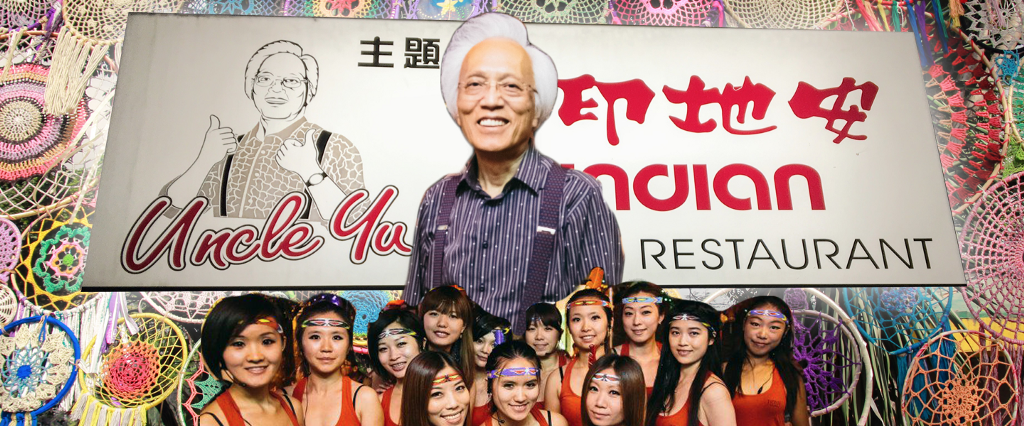There’s a chance that you could stumble into Uncle Yu’s restaurant and not really notice the decor on the walls or the uniforms of the all-female wait staff, considering how easy it is to get lost in the big menu of bubbling stews, crispy-crunchy snacks and grilled skewers of meat dappled with sweetened soy sauce. Equally distracting are the crazy-low prices for pitchers of beer, all in the low teens.
Once you look up from the menu, though, you might see a wolf’s skin stretched wide and mounted behind plexiglass, or the ceremonial spear adorned with fur and feathers hanging on a nearby wall next to smiling Polaroids of regular guests. One section of the dining room features a grand woven dreamcatcher, decorated with a painting of a serious-looking Native American elder with a feather headdress. An adjacent shelf has three small clay figurines of Native American men, standing in fixed elation under a neon sign that blares “KIRIN,” the beer sold here for a paltry $13 a pitcher.
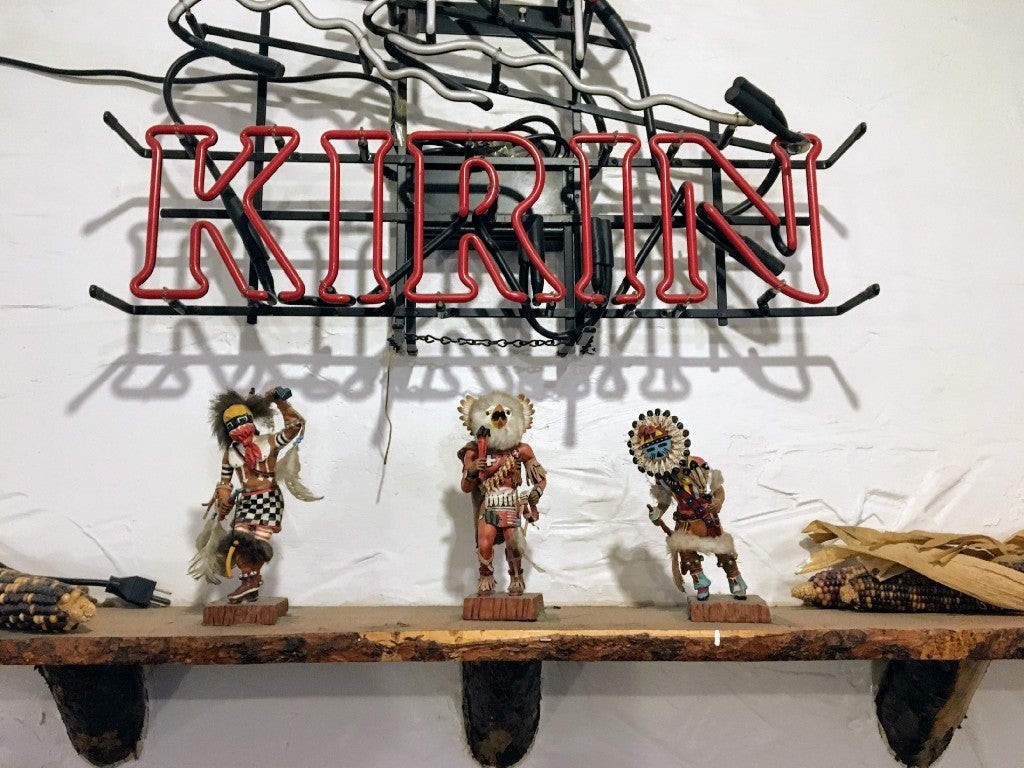
And it’s likely you would eventually notice that the photogenic young Asian woman serving you that pitcher is wearing a short pleated skirt, a thin tank-top and, crucially, a feather in her hair — sticking straight up from a beaded headband, like the ones used in so many faux-Pocahontas costumes that you see crop up during Halloween and at Coachella.
The full name of the establishment, after all, is Uncle Yu’s Indian Theme Restaurant — “Indian” as in “Native American,” not relating to the country of India. Tucked away in a small strip mall off a major boulevard in San Gabriel, Uncle Yu’s has served beer, Taiwanese food and Native American kitsch for nearly two decades. It’s an odd sight in a time when racism and appropriation in restaurants is under more scrutiny than ever.
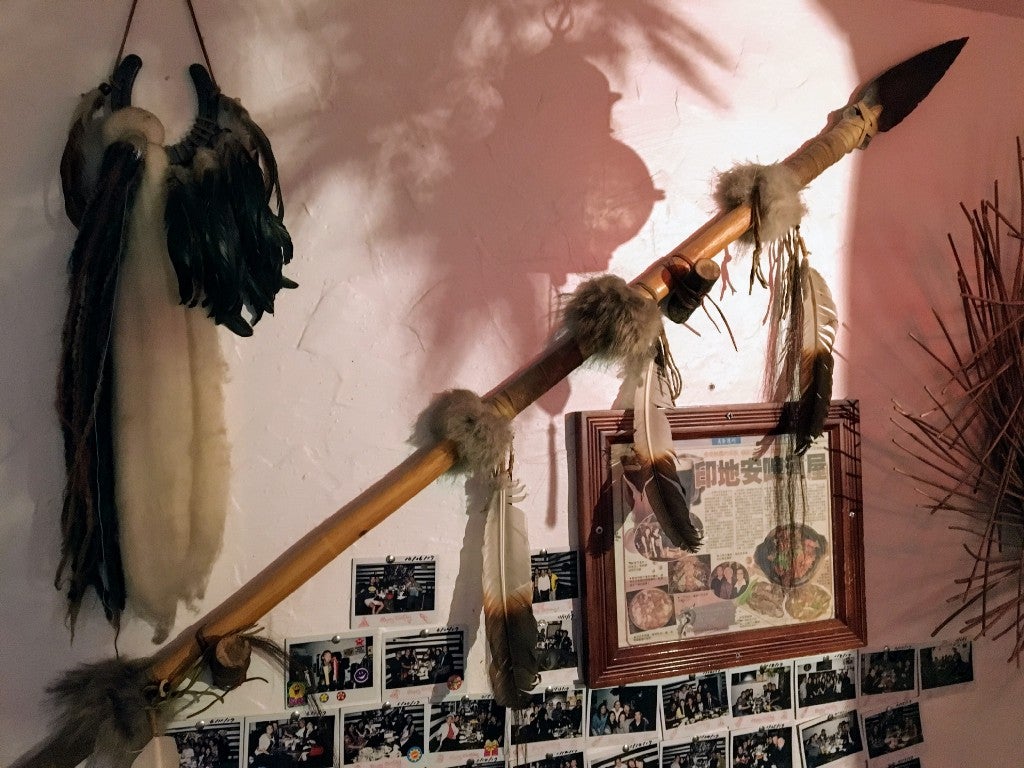
San Gabriel is in Los Angeles County, a dozen miles east of Downtown L.A., but it’s both geographically and culturally distant from the Los Angeles that most recognize from pop culture. It’s a flatland defined by strip malls and single-family homes, like so many other suburbs in L.A., except here you see a lot more Mandarin on the signs — and many, many more Chinese and Taiwanese faces to match. In one of the most diverse counties in America, the city of San Gabriel stands out, with a stunning 49% of the population identifying as Asian.
This region attracts Chinese nationals in particular, with multiple waves of immigration over the last 30 years crafting the business and social landscape in the San Gabriel Valley. One can feasibly live in comfort here without speaking much English, as it is in L.A.’s Koreatown and many Latino enclaves around Southern California, like Boyle Heights. And, much like in those neighborhoods, the restaurants here serve an erudite bunch of diners. San Gabriel’s thicket of excellent Chinese and Taiwanese restaurants has a reputation for value and flavor; people flock to this valley to eat because they know what zajiang noodles from Chengdu or the “three-cup chicken” stir-fry from Taipei is supposed to taste like.
It’s easy to imagine that a restaurant that appropriates Native American imagery as literal decor and nothing more would get a flood of negative press and attention if it were located somewhere less low-key, perhaps in Santa Monica or Beverly Hills. It’s even easier to imagine that if the proprietor was a white person. But out east in San Gabriel, nobody seems to really care. “We haven’t gotten any complaints, really. Once in a while somebody comes and complains because they think we serve Indian food,” says Ting Yeh, a waitress at Uncle Yu’s who has been working there for 15 years, since she first moved here from Taiwan to go to college. “We get a good mix of customers, too. Young, old, different races.”
Yeh’s account rang true at Uncle Yu’s on a recent buzzy Tuesday night, where I scoped a group of young Vietnamese guys bickering away over grilled skewers, a three-generation family sitting down for a feast of stews and rice, and a group of college kids joking about what the menu’s listing of “squid lips” could possibly be. Were we all just passively taking part in cultural insensitivity? How could we not be?
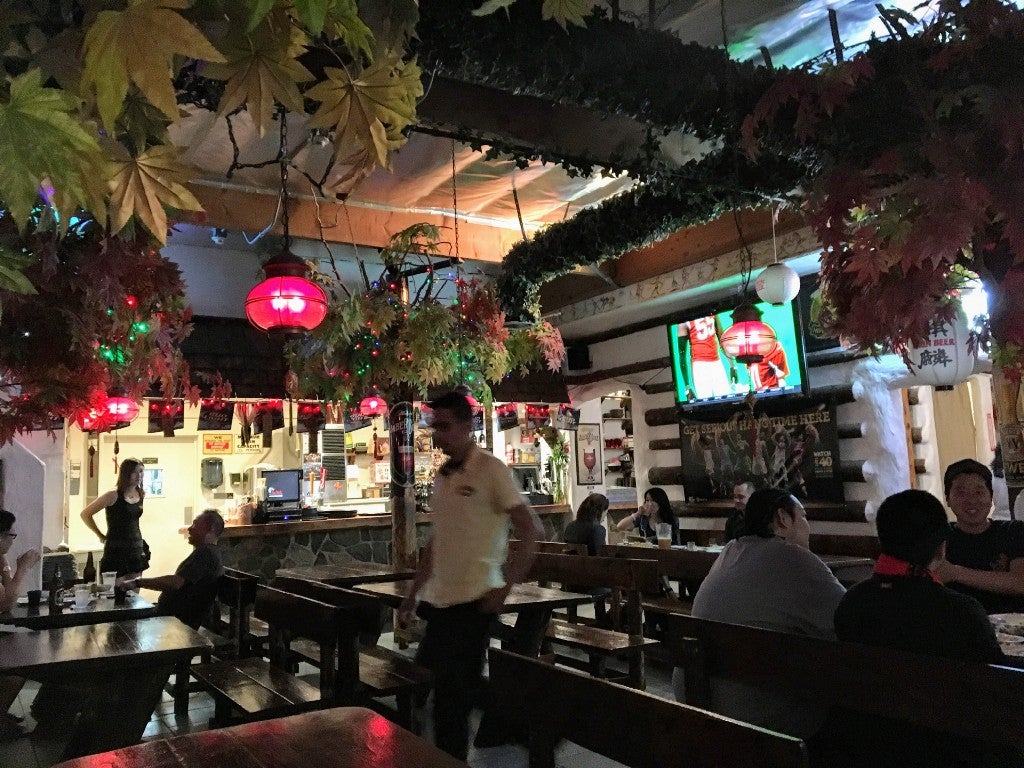
Cultural appropriation in restaurants became a flashpoint for a national debate last year when a Portland burrito shop got hit with a massive backlash after its owners, two white women, revealed that they had gone to Mexico for a short trip and cribbed kitchen recipes and techniques by “peeking into the windows of every kitchen.” The crux of the debate was how white chefs and restaurateurs profit off of the labor and intellectual property of minority groups, especially when lesser-known foods become trendy for mainstream America.
Uncle Yu’s does not fit into that debate neatly, considering that it was founded by a Taiwanese couple to serve Taiwanese food. Su Yu Feng Yu and husband Wen Tiung Yu opened it nearly two decades ago after immigrating from Taiwan, where they had run a similar restaurant with Native American kitsch. It’s part of a broader, years-long trend of theme restaurants around Asia, with iterations as weird and varied as toilet-themed curry shops, “communist” hot pot spots, and alpaca cafes.
While few of these are controversial, the Asian love of odd imagery as a source of levity has been hugely problematic at times. “Nazi-chic” fashion was a literal trend in a number of Asian nations, with a group of Taiwanese high schoolers getting international attention for a mock Nazi parade in 2016. Experts note that a lot of it has to do with ignorance, as cultural sensitivity isn’t taught or discussed as much as it is in the U.S. Whatever the cause, casual racism and xenophobia, either explicit or implied, remains an undercurrent in many Asian cultures, whether it’s a distaste for darker skin or a willingness to exhibit photographic art that compares black people to literal apes.
“If you grow up Asian, there’s always this casual, permitted racism you run into. Not malicious, but not okay either,” says Matt Kang, Korean-American food writer and editor of Eater Los Angeles. “There’s a xenophobia element that’s not acceptable but at least explainable because of the homogeneity in Asian countries. You go to Korea or Japan or Taiwan, and everyone’s more alike than not.”
As a Korean-American immigrant kid myself, having contended with family members who spout casually racist stereotypes, I can see why something like beautiful Native American imagery wouldn’t register as offensive to a lot of Asians. In fact, a memorable touch like that is probably a savvy business move in restaurant markets where competition is fierce, as Clarissa Wei, a Chinese-American writer who grew up in L.A., points out.
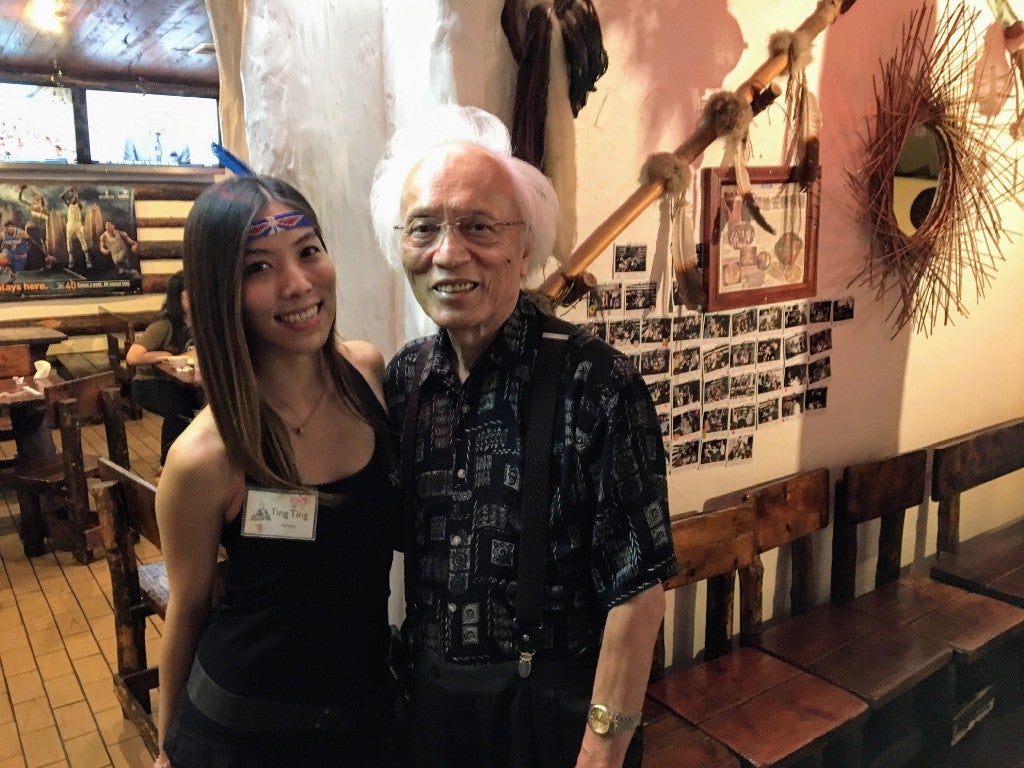
“Keep in mind that Yu’s is an older San Gabriel Valley establishment, and back then, conversations surrounding cultural appropriation weren’t as dominant as they are now. Uncle Yu’s is incredibly tacky and cheeky and inappropriate, but that’s become part of its charm,” Wei notes. “Hell, even decades after its opening, people are still talking about a kitschy Taiwanese bar place that’s Native American-themed. That’s good marketing, whether we like it or not.”
Using Native American imagery as a marketing tool certainly isn’t new in America, land of the Cleveland Indians’ ridiculous Chief Wahoo mascot, Urban Outfitters’ “Navajo Hipster Panties,” Gwen Stefani’s ill-fated “Looking Hot” music video, Victoria’s Secret model Karlie Kloss in a big ceremonial headdress, and the fucking Washington Redskins. Uncle Yu’s, like some of these entities, appears to understand the risk of being called out — “I think it’s interesting to note that over the years, Uncle Yu’s has been less forthcoming about their Native American theme, at least in their online marketing. This is no doubt because of the Yelp generation and social media outcry,” Wei told me.
On the other hand, it also hasn’t committed to the simple act of changing the decor, which is situated on the walls without any context of what the item is, which tribe’s tradition it belongs to, what it may represent. Wolf skins, for instance, were worn by Crow tribespeople during a hunt, whereas the Cherokee would never have killed a wolf to begin with. These distinctions matter because presenting items for show, without meaning, over time erases the history of the people who created them, writes Chelsea Vowel, a Métis writer and educator, on her blog âpihtawikosisân.
“For instance, eagle feathers are restricted symbols in the many indigenous cultures found throughout Canada and the U.S. They represent various achievements made by the person who is presented with the feather,” Vowel writes. “Because of the significance of the eagle feather, very few native people would display feathers they haven’t earned… When everyone is running around with a copy of that symbol, then it is easy to forget that some people have to earn it and that it means something.”
Critiquing Uncle Yu’s becomes challenging when you add in the factor of power dynamics: Asians are not the dominant patriarchal force in American culture in the same way that white people are, yet Yu’s kitsch undermines some of America’s most maligned and underrepresented ethnic minorities. People of color absolutely can and do appropriate, as when Pharrell wears a giant headdress on the cover of Elle. But sitting in Uncle Yu’s made my mind wander through an array of thought experiments: What would we say about a black-owned soul-food joint decorated in stereotypical images of Asian spirituality and martial arts? Or a Latino-owned taco shop themed around blaxploitation films?
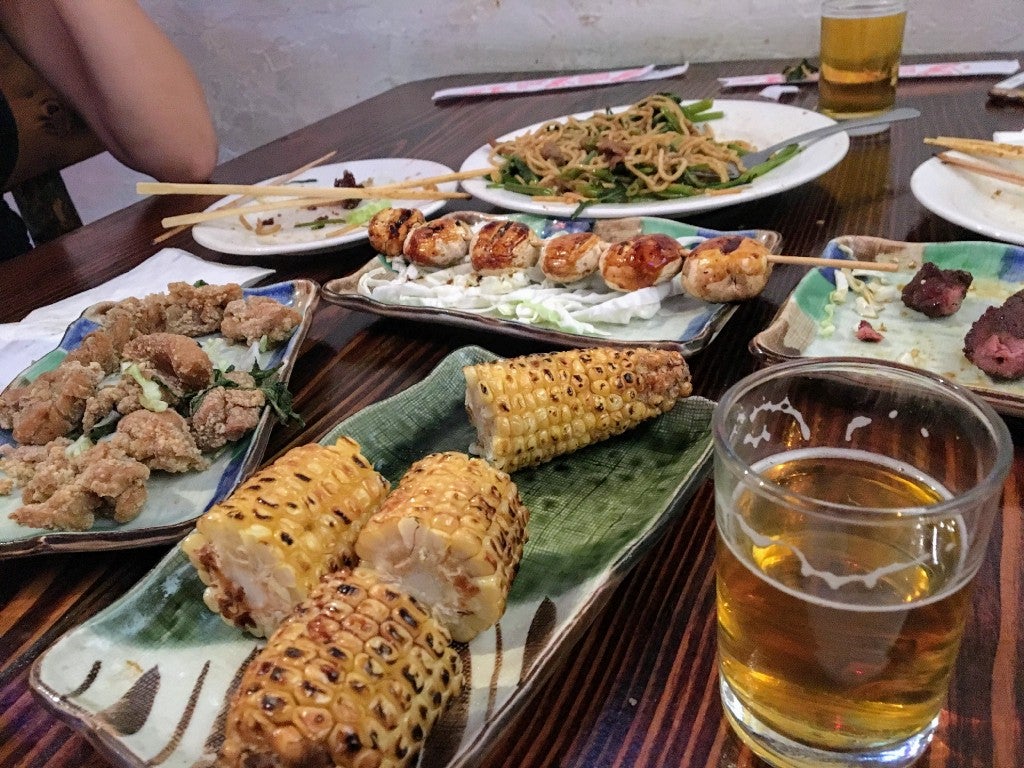
It would also be much easier to condemn Uncle Yu’s if it was flat-out bad (like the fucking Washington Redskins). I walked into my recent meal there almost hoping that I would hate the experience. Instead, I found myself grinning as I stuffed my mouth with lamb noodles slicked with garlicky oil, and popcorn chicken fried with fragrant basil leaves, and addictive little skewers of grilled beef. I was more offended the last time I was at a Hooters, when I saw two drunk middle-aged guys leering at a young brunette server and had to chew through a plate of surprisingly shitty wings.
In that sense, Uncle Yu’s is just another American business that will get away with what it can as long as the bottom line isn’t hurt. As Kang observes, the restaurant being run by a non-white owner blunts the edges of the appropriation itself (“It’s offensive, no doubt, but we Asians weren’t around to oppress Native Americans in the same way as white American society did”). That being said, he and others also acknowledge that continuing to participate in stereotypes is a legitimate harm— as Cherokee Nation member and academic Adrienne Keene writes in her blog Native Appropriations, use of appropriative imagery “furthers the stereotype that Native peoples are one monolithic culture, when in fact there are 500+ distinct tribes with their own cultures. It also places Native people in the historic past, as something that cannot exist in modern society. We don’t walk around in ceremonial attire everyday, but we still exist and are still Native.”
Maybe the shame here is that the theme could be changed without much detriment to the business, as food writer (and Taiwanese-American) Esther Tseng adds. She already avoids any restaurants tied to exploitative practices or stories of abuse (like L.A.’s Hearth & Hound, the former project of Ken Friedman, the subject of numerous sexual harassment claims), and is wary of trying Uncle Yu’s for the first time.
“I would feel uncomfortable. I’ve ragged on white girls wearing headdresses to Coachella, considering Native American women can’t even wear them out of tradition. It would be wrong to give Uncle Yu’s a pass,” she says. “As Asians, we do need to hold each other accountable.”
As I walked out of Yu’s, stomach full of various meats and a couple pints of cheap lager, I realized that I had the opportunity to say something about the need for the restaurant to change its theme…but didn’t. Why? I guess I leaned into the justifications for leaving it be, including that Uncle Yu’s is a mom-and-pop restaurant in a San Gabriel landscape that’s changing due to rising rents, gentrification, and an influx of mainland China restaurant chains. The fact that I enjoyed the experience, though, left me unsettled as I lay in bed that night.
The next morning, I concluded that I just wouldn’t go back to Uncle Yu’s anymore — something I discussed with Tseng and Kang, who were mostly in agreement. Too little too late, perhaps, given I do believe Asians need to hold each other accountable. It sure is harder, though, when you would rather rail on the bigger problems of whiteness instead.
